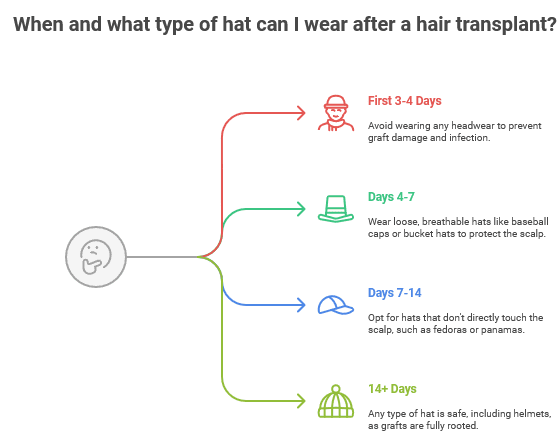Gone are the days where hair loss treatments were still unable to provide completely natural-looking results, and when Follicular Unit Transplantation (FUT) left a long scar on the back of the head. Today, the latest procedures are minimally invasive and patients heal up relatively quickly, but there is still a need to cover those initial post-op signs.
There is swelling, redness, tiny scabs, and even some light bleeding during the first week, and so an obvious solution people go to is to simply wear a hat to cover everything up. Is this a safe thing to do? Let’s find out.
Wussten Sie schon?
Laut dem ISHRS Practice Census Report 2025 gaben 85.7 % der Patienten an, dass sie sich nach einer Haartransplantation selbstbewusster fühlen. Diese Zahl unterstreicht, wie wichtig auch scheinbar kleine Fragen wie das Tragen eines Huts nach dem Eingriff sind – denn Komfort und Sicherheit in der Heilungsphase spielen eine große Rolle im Gesamtergebnis.
Can You Wear a Hat After Hair Transplant Surgery?
With the modern technique known as Follicular Unit Extraction (FUE), individual grafts are carefully extracted, preserved in a special solution, and after incisions have been made in the recipient area, are implanted one-by-one with great precision.
While this offers incredible success rates, typically 95% to 98%, and causes minimal tissue damage, the transplanted hair follicles still need some time to take root and strengthen. Wearing a tight fitting hat immediately after the operation, and for a few days later, can cause issues, but it is possible to wear certain types of hats a bit later during recovery.
In fact, it’s a good way to protect the still sensitive areas of the head from UV radiation and various dust particles that could cause an infection.
When Can You Start Wearing a Hat?
Now that you know that it is not only possible, but also recommended to use headwear to keep the scalp protected during the hair restoration process, it’s important to define when you should do it. A common question clinics get is: “How many days after a hair transplant can I wear a hat?”
The crucial rule to remember is that you need to avoid putting anything on your head for the first 3–4 days after the operation. On days 4–7, you can begin wearing very loose fitting hats, while being extra careful not to put any direct pressure on the hair.
After the first week, any type of hat is perfectly fine, except helmets, as these are usually more tight-fitting and heavier, and you should wait about two weeks before wearing helmets again.

What Types of Hats Are Safe to Wear?
After the first three days, you can go with a loose fitting adjustable baseball cap, and bucket hats also work quite well. Once you’ve gone past the first two weeks, you can basically choose whatever you want, just focus on softer models made of breathable materials.
Days after surgery | Safe to Wear / Fit | Hat Types |
0–4 | Not safe | No headwear |
4–7 | Loose and breathable | Baseball cap, bucket hat |
7–14 | No direct scalp contact | Fedora, cowboy, panama |
14+ | Any fit and tightness | Beanie, winter, ski, helmet, etc. |
Some options can pull on your follicles when you take them off, so you’ll need to wait until everything is fully healed and strong.
Tips for Safe Hat Wearing Post-Transplant
The main thing to remember is that you should let your scalp breathe and avoid touching it for the first three or four days after the surgery. The first week is a crucial time in the healing process, but you can go with light, adjustable options that you can wear super loosely.
Avoid anything that comes in direct contact with the top of the head for about two weeks, and always wear a hat when going outside to protect the scalp from the sun. Slowly introduce tighter-fitting sports of winter headwear after this, including helmets, and take a bit longer if you start feeling any pain when you first put them on.
What Happens If You Wear the Wrong Hat Too Early?
Putting on a tight hat right after the hair transplant procedure can pull out the newly transplanted grafts, as they still aren’t rooted properly and are more susceptible to damage and falling out. You can even cause an infection during the first few days.
When to Contact Your Doctor
When you get a hair transplant in Istanbul, your doctor will give you a detailed aftercare plan, outlining the whole process and giving you a precise timeline. They will also tell you about the main causes for concern and signs of unwanted side-effects.
In general, you should contact the clinic for advice if you have noticed excessive bleeding, chronic pain, and color changes that could be indicative of an infection, or if the new hair is falling out during the first week or two. If your recovery is not progressing according to the common timeline your doctor has discussed with you, this can also be a bad sign.
FAQs
Can I wear a hat to my hair transplant appointment?
Even though it may not seem like a problem to wear a hat before the surgery, you should avoid it for at least 24 hours prior to the surgery. The reason is that they can cause a buildup of bacteria and debris, which can lead to an infection during the procedure. The morning of the operation, wash your hair thoroughly, and don’t wear anything on your head.
How long should I wait before wearing a helmet after a hair transplant?
It takes about two weeks for your new hair grafts to fully take root and the scabs to fall off on their own, after which it will be safe to wear tight-fitting headwear like helmets. Some clinics may recommend waiting for a couple of more weeks just to be on the safe side, but 14 days is a minimum.
What kind of hat is best immediately after a hair transplant?
An oversized adjustable baseball cap, especially very light or ones with a mesh material is your safest choice, followed by a roomy bucket hat a couple of days later. You essentially want it to be as light and breathable as possible and tall enough not to touch the top of the head directly.
Will wearing a hat cause sweating that harms the grafts?
It could, which is why it’s important to avoid wearing one for the first few days post-op when you are at the highest risk of developing an infection.

